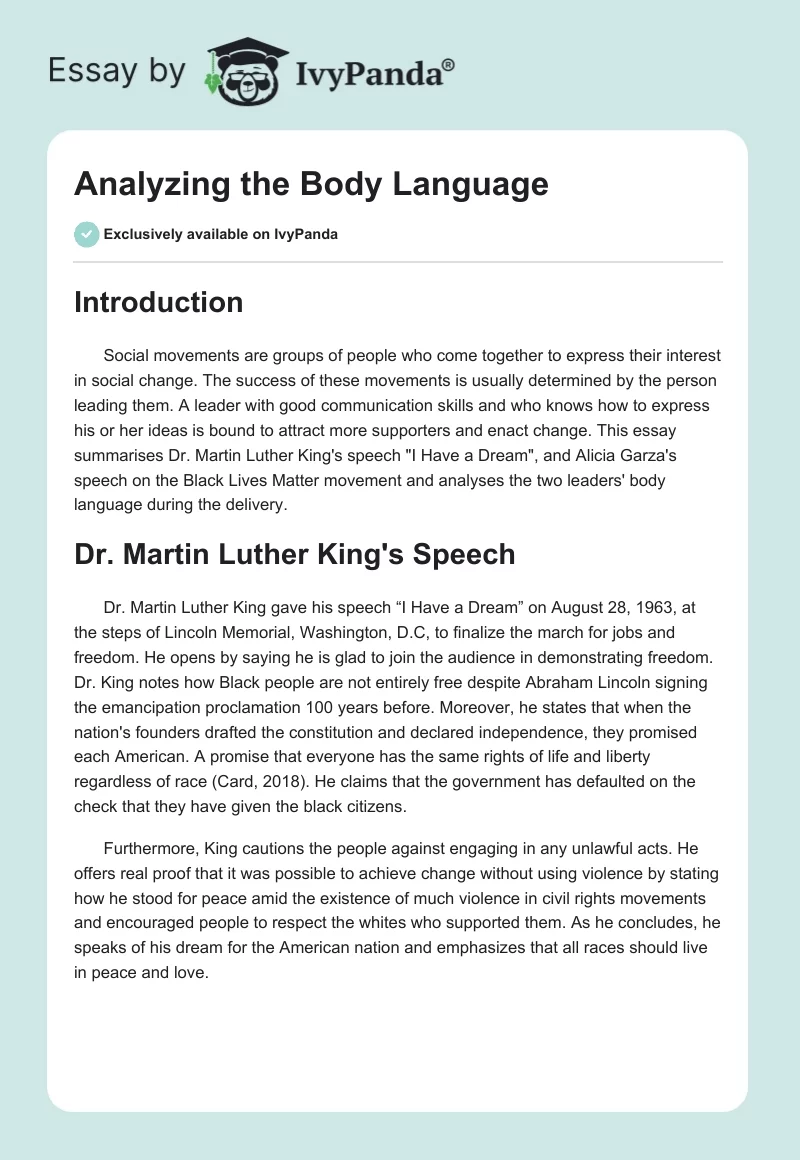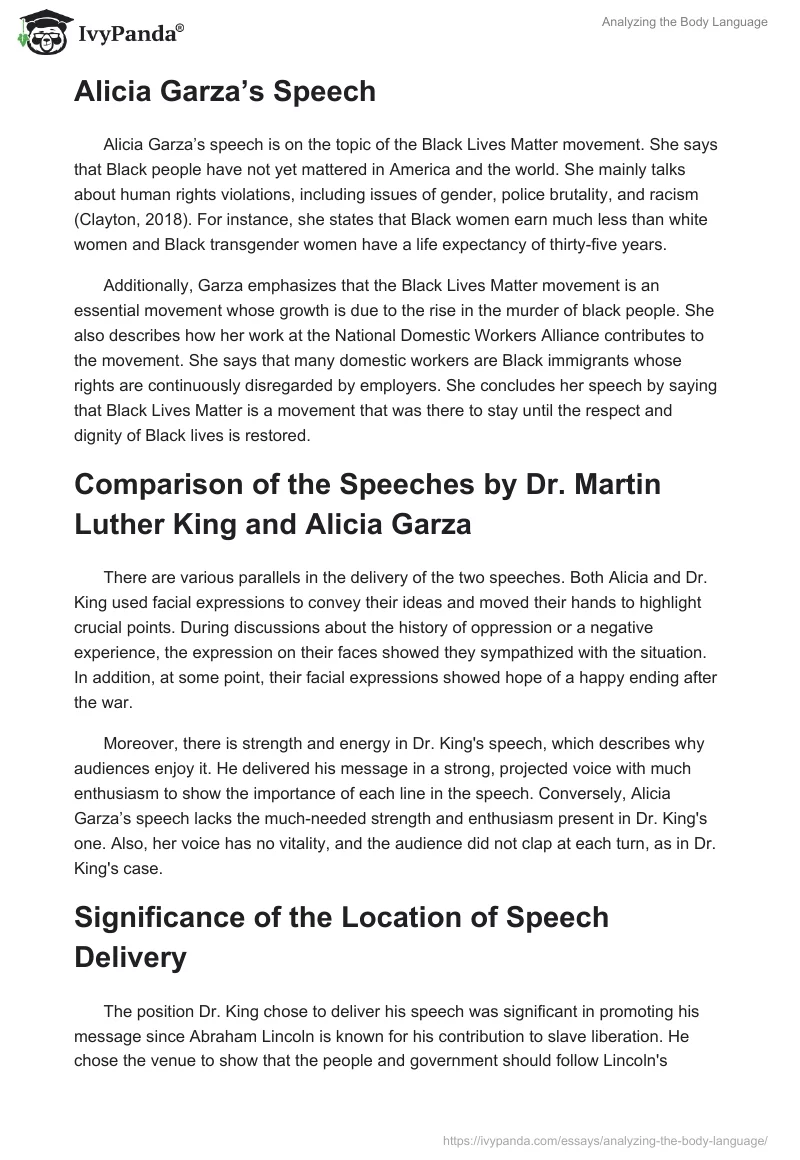Introduction
Social movements are groups of people who come together to express their interest in social change. The success of these movements is usually determined by the person leading them. A leader with good communication skills and who knows how to express his or her ideas is bound to attract more supporters and enact change. This essay summarises Dr. Martin Luther King’s speech “I Have a Dream”, and Alicia Garza’s speech on the Black Lives Matter movement and analyses the two leaders’ body language during the delivery.
Dr. Martin Luther King’s Speech
Dr. Martin Luther King gave his speech “I Have a Dream” on August 28, 1963, at the steps of Lincoln Memorial, Washington, D.C, to finalize the march for jobs and freedom. He opens by saying he is glad to join the audience in demonstrating freedom. Dr. King notes how Black people are not entirely free despite Abraham Lincoln signing the emancipation proclamation 100 years before. Moreover, he states that when the nation’s founders drafted the constitution and declared independence, they promised each American. A promise that everyone has the same rights of life and liberty regardless of race (Card, 2018). He claims that the government has defaulted on the check that they have given the black citizens.
Furthermore, King cautions the people against engaging in any unlawful acts. He offers real proof that it was possible to achieve change without using violence by stating how he stood for peace amid the existence of much violence in civil rights movements and encouraged people to respect the whites who supported them. As he concludes, he speaks of his dream for the American nation and emphasizes that all races should live in peace and love.
Alicia Garza’s Speech
Alicia Garza’s speech is on the topic of the Black Lives Matter movement. She says that Black people have not yet mattered in America and the world. She mainly talks about human rights violations, including issues of gender, police brutality, and racism (Clayton, 2018). For instance, she states that Black women earn much less than white women and Black transgender women have a life expectancy of thirty-five years.
Additionally, Garza emphasizes that the Black Lives Matter movement is an essential movement whose growth is due to the rise in the murder of black people. She also describes how her work at the National Domestic Workers Alliance contributes to the movement. She says that many domestic workers are Black immigrants whose rights are continuously disregarded by employers. She concludes her speech by saying that Black Lives Matter is a movement that was there to stay until the respect and dignity of Black lives is restored.
Comparison of the Speeches by Dr. Martin Luther King and Alicia Garza
There are various parallels in the delivery of the two speeches. Both Alicia and Dr. King used facial expressions to convey their ideas and moved their hands to highlight crucial points. During discussions about the history of oppression or a negative experience, the expression on their faces showed they sympathized with the situation. In addition, at some point, their facial expressions showed hope of a happy ending after the war.
Moreover, there is strength and energy in Dr. King’s speech, which describes why audiences enjoy it. He delivered his message in a strong, projected voice with much enthusiasm to show the importance of each line in the speech. Conversely, Alicia Garza’s speech lacks the much-needed strength and enthusiasm present in Dr. King’s one. Also, her voice has no vitality, and the audience did not clap at each turn, as in Dr. King’s case.
Significance of the Location of Speech Delivery
The position Dr. King chose to deliver his speech was significant in promoting his message since Abraham Lincoln is known for his contribution to slave liberation. He chose the venue to show that the people and government should follow Lincoln’s declarations. Also, Dr. King delivered his speech in a church since he believed all humans are created equally by God, so slavery and hatred should not exist. King understood that these injustices do not conform with Biblical teachings and thus have to be eliminated.
Technology today has advanced, and ways of transmitting knowledge have also changed. There has been the evolution of powerful spaces such as social media to communicate and discuss issues easily. Therefore, choosing an avenue is crucial and makes a difference (Miller et al., 2021). Since Americans adore history, monuments to great leaders who championed freedom and equal rights are symbolic and legendary. It will pique many people’s interests if civil rights activists return to the exact location and deliver their speech where King did.
The Difference in the Speeches and Audience
There is a wide- range of differences in the audiences of Dr. King and Alicia. The delivery form quickly linked Dr. King’s audience to the speech since he delivered with much energy, passion, and strength that infused people’s minds. On the other hand, Alicia’s audience does not have much interaction with her. Her voice is not very strong and compelling, and the listeners get easily bored. In conclusion, body language is crucial in speech delivery as it ensures the audience connects and relates to the speaker’s message.
Conclusion
The speeches by Dr. Martin Luther King and Alicia Garza highlight the issues being faced by Black people in America. Dr. King focuses mainly on freedom and equality for black Americans, while Alicia Garza mostly speaks against racism and police brutality. There are various similarities in the two leaders’ body language during speech delivery, such as a change in facial expression and movement of hands. However, there are key differences, ranging from the strength and vitality of their voices to the audience’s reaction to the speeches.
References
Card, M. M. (2018). Dr. Martin Luther King Jr.’s” I Have a Dream” Speech: An Exploration and Analysis of Personal, Cultural, and Collective Complexes in the Foundation of the Dream and the Life of Dr. King. Journal of Heart-centred Therapies, 21(2), 3-28. Web.
Clayton, D. M. (2018). Black lives matter and the civil rights movement: A comparative analysis of two social movements in the United States. Journal of Black Studies, 49(5), 448-480. Web.
Miller, T., Aladro-Vico, E., & Requeijo-Rey, P. (2021). The Hero and the Shadow: Myths in Digital Social Movements. Comunicar: Media Education Research Journal, 29(68), 9-20. Web.


